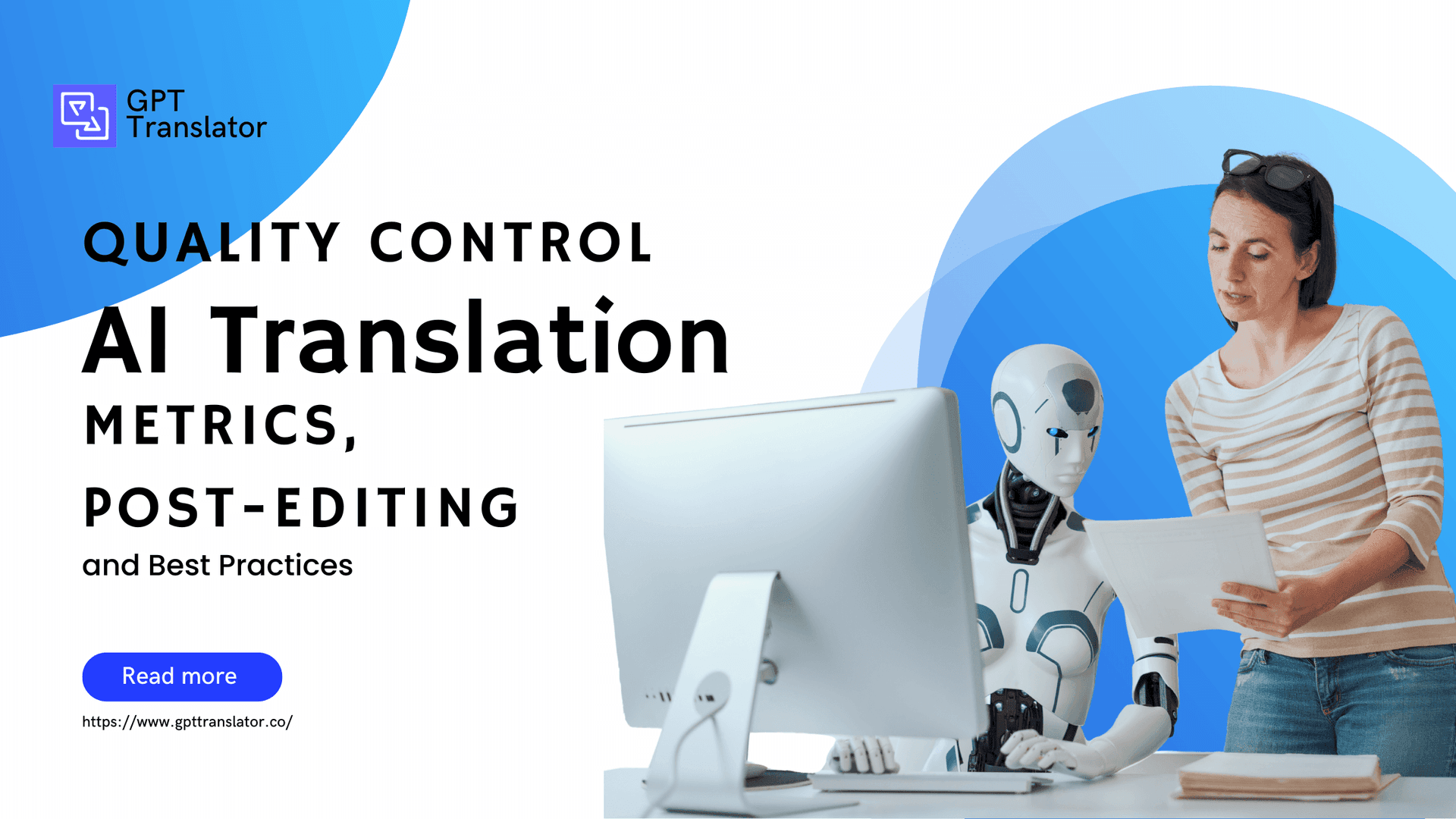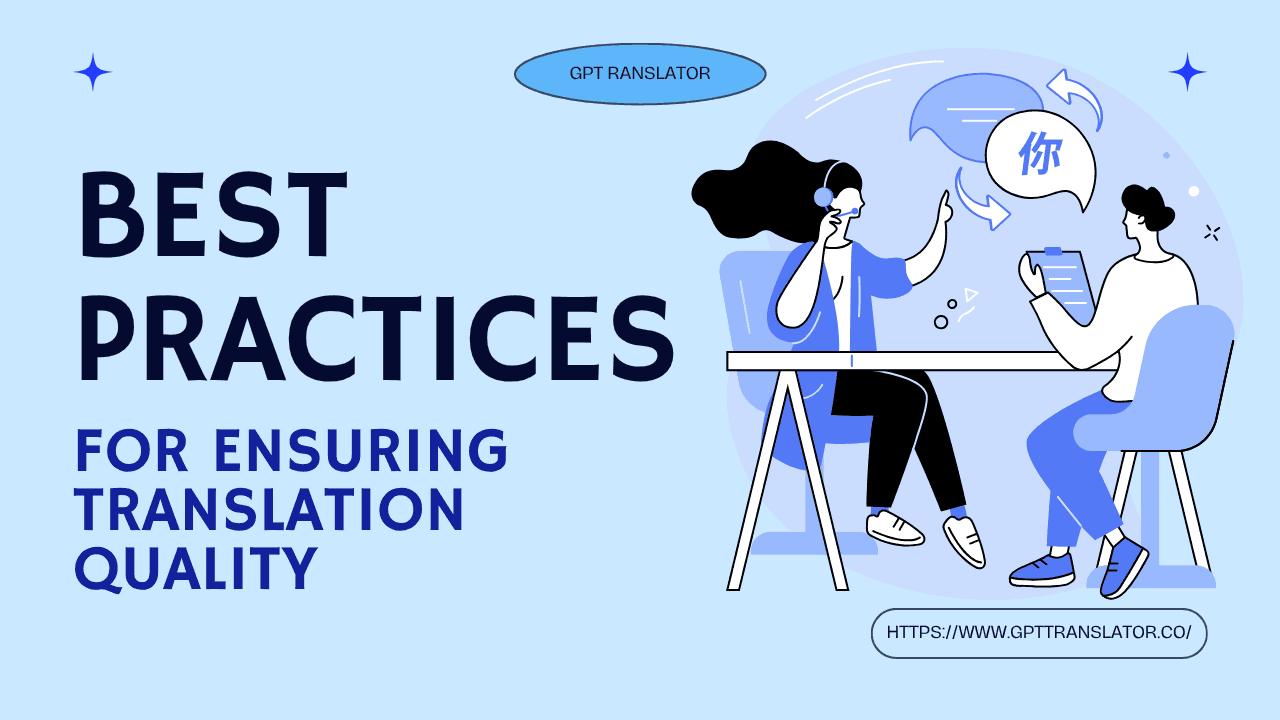Quality Control in AI Translation: Metrics, Post-Editing and Best Practices

The facts state quite simply that despite the fact that the smartest AI such as ChatGPT and a GPT translator still demand the input of a human being to get to the best possible quality. In this blog post, we will discuss the importance of quality control, the role of post-editing in enriching AI output and the possibilities of getting the best of both worlds human accuracy and GPT intelligence for translation that is both reliable and natural sounding.
Why Translation Quality Still Matters in the Age of AI
With GPT translate, one can get a page of text translated in seconds. But is that perfect? Not necessarily.
A translated badly sentence may be the case of losing brand trust, misunderstanding customers and even altering the meaning completely. Take the case of a simple product instruction which has been mistranslated into the foreign language of the customer which may lead to customer frustration and worse, product misuse.
Global audience-dependent businesses cannot afford to make the same mistake. Whether it is e-commerce descriptions, legal documents and marketing campaigns, the accuracy of translation directly impacts both reputation and revenue.
This is the reason why despite the fact that tools such as ChatGPT translation are very powerful, they still need quality control measures metrics, human post editing and structured feedback to guarantee that every single term used is in accordance with the brand voice and intent.
The Common Challenge: When AI Translations Miss the Mark
AI translators, including ChatGPT translator are great at managing large amounts of text very quickly. But at times they:
Not only lose contextual meaning (for example, idioms, humor and sarcasm) but also get it wrong in certain cases.
Fail to understand and struggle with specific jargons from certain industries.
Deliver documents where the tone and terminology used is inconsistent throughout the text.
Translations that are over-literal resulting in sounding very unnatural.
Picture a high-end fashion brand going into the Japanese market. The phrase in English "Effortless elegance" may be translated directly in Japanese as "easy and simple." It's correct from the technical point of view but loses the emotional nuance which is the brand's defining characteristic.
This is where post-editing and quality metrics come into play they help to close the gap between machine precision and human emotion.
The Solution: A Human-Centered AI Translation Workflow
Rather than doing away with the human translators, the GPT-based Translation tools are now being used to empower them. The more advanced companies regard AI as a partner not as a substitute.
Thus, a modern quality oriented translation workflow can be illustrated as follows:
AI Translation (ChatGPT translate): First of all the text is translated by GPT-based models. The models are able to grasp the general meaning and grammar of the text rather quickly and in an efficient way.
Post-Editing by Experts: A group of human linguists goes through the text and checks it for cultural relevance, tone and accuracy. They also make sure that the company's branding is consistent and that idioms and region specific phrases are mentioned in a natural way.
Quality Evaluation with Metrics: The quality of the translation is measured and at the same time, the areas for improvement are identified through the use of advanced technology and tools like BLEU, COMET and MQM that are part of the quality evaluation process.
Continuous Learning: The system's feedback loop maintains the GPT translator model's capacity to improve gradually with time.
This mix offers the advantages of speed, scalability and precision all of which cannot be attained with pure human translation or AI alone.
Key Metrics for Measuring Translation Quality

1. BLEU (Bilingual Evaluation Understudy)
The machine translated text is compared to the human approved translation. The higher the BLEU score the closer your AI translation is to human output.
2. COMET (Cross lingual Evaluation Metric)
COMET evaluates the matching of the meaning and the fluency by applying neural networks. It’s more context-aware than BLEU which is an advantage for ChatGPT translation evaluations.
3. MQM (Multidimensional Quality Metrics)
MQM discloses the detailed error analysis from grammar and terminology through style and consistency. It is commonly utilized in professional post-editing workflows.
These metrics do not only assess performance, they also provide guidance for improvement. They can be revolutionary in the field of trans-editing if employed in conjunction with the feedback given by post-editors.
Post-Editing: The Human Touch That AI Still Needs
Even the most advanced artificial intelligence models for translation such as ChatGPT translator can still falter at times when it comes to tone and emotion. That’s why post-editing becomes so important.
Post-editors work on more than just grammar they:
Make sure the tone fits the target culture. Consistency of technical terms is maintained. Adapt idioms and metaphors that would not be understandable otherwise. Check the translated text against brand style guides.
For example, in marketing “limited-time offer” in English might be translated as direct but could not create that sense of urgency in another language. So a post-editor ensures it is persuasive enough in the local culture.
Two Levels of Post-Editing
Light Post-Editing: Corrects grammar, translates meaning, and reads well. Excellent for internal documents or quick updates.
Full Post-Editing: This process need substantial editing for tone, subtlety and feeling. It is a must for customer-oriented content or branding material.
Incorporating artificial intelligence-powered translator tools with proficient post-editors can help companies to realize as much as 70% reduced turnaround times all with the same quality.
Worldwide E-commerce Growth
Let us consider a practical case.
A worldwide e-commerce company intended to have its over 10,000 product listings translated into five languages: Spanish, French, Japanese, German and Italian.
The company utilized ChatGPT translation to automate the first phase of translation. The total time saved was over 60% compared to the traditional ways of translating.
Next professional linguists complete the post-editing with high quality of tone and culture expectations.
Lastly, the metrics (BLEU and MQM) were utilized to determine the accuracy and consistency across markets.
Outcome: There was a 45% rise in the company's international sales and customer satisfaction scores in non-English-speaking areas also improved considerably.
The case indicates how AI automation can be combined with human proficiency to yield efficiency with no compromises.
Best Practices for Ensuring Translation Quality

1. The creation of a Comprehensive Style Guide
Specify tone, voice, and brand terms pre-translation. Thus, it will be possible to keep up the same level of quality throughout the content.
2. Make Use of Translation Memory Tools
Join GPT-based models with translation memory systems to take advantage of already approved translations.
3. Carry Out Regular Quality Checks
Put in place automated QA tools to detect spelling, grammar and formatting errors at the earliest.
4. Train AI with Domain-Specific Data
Making your ChatGPT translation model based on your industry specific case examples will provide the context that is understood and less repetitive errors.
5. Combine Machine + Human Review
The unbeatable formula for victory: AI for speed, humans for finesse. This mixed-up model ensures the highest accuracy and a natural flow of words.
Why GPT Translator Is a Game-Changer
By contrast to previous generations of machine translation, GPT models can recognize the context, tone and even intention more than ever.
What distinguishes them from the others are the following:
Context-Aware Output: The output produced by GPT models is not merely a word-for-word translation, it reflects the understanding of the meaning on a sentence level.
Adaptive Learning: They have the ability to receive feedback from users and consequently develop their performance.
Multilingual Mastery: Trained in hundreds of languages translate GPT is capable of working with both widely spoken and low resource languages.
Seamless Integration: It is possible for companies to include ChatGPT translate in their CMS, chatbots and localization workflows directly.
Translators are not going to be eliminated, rather their contributions will be multiplied.
Quality Is the Only True Indicator of Translation Success
The speed is a factor but the quality of trust is the ultimate source. Organizations that take advantage of the GPT translation speed along with the human expertise do not only save time they are better at communication become more connected and are faster in their growth in the worldwide market.
When translation quality control is implemented through metrics, post-editing and best practices your message will still be very authentic regardless of the language used.
Are You Ready to Take Your Translations to the Next Level?
Find out how ChatGPT translation can easily help you to scale high-quality, human-validated translations. Let us make your global content sound natural, correct and engaging in all the languages.